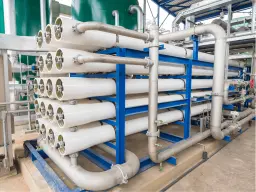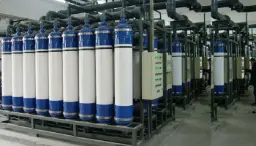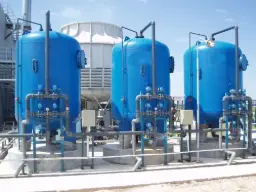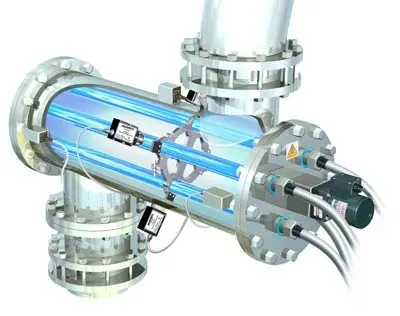Well Water Treatment
Groundwater extracted from on-site wells is a critical utility in countless industries, from food & beverage and pharmaceuticals to mining and power generation. Yet the raw well water that first emerges from an aquifer rarely meets the stringent quality specifications demanded by modern production lines or boiler houses. Geochemical interactions between percolating rainwater and surrounding strata typically load the water with dissolved hardness ions, iron, manganese, hydrogen sulfide, silica, and naturally occurring organic matter. In addition, seasonal turbidity spikes driven by heavy rainfall or agricultural activity can introduce suspended solids and colloidal clay. If these contaminants remain unchecked, they foul heat-exchange surfaces, scale reverse-osmosis (RO) membranes, poison catalysts, discolor end-products, and violate international standards for potable and process water. A robust Well Water Treatment strategy therefore serves two vital functions: firstly, protecting downstream unit operations and capital equipment; secondly, ensuring every cubic metre of process water consistently conforms to regulatory as well as customer-driven specifications.
Unlike municipal feedwater, which is usually chlorinated and partially clarified, well water shows wide-ranging variability in pH, oxidation-reduction potential (ORP), bacterial load, and mineral balance even within the same property line. Engineers must therefore design flexible, multi-barrier treatment trains that can accommodate gradual aquifer drift and sudden upsets without expensive downtime. Implementing data-driven control loops, energy-efficient pumping, smart chemical dosing, and modular skid layouts has become the hallmark of next-generation well water purification. The trend toward Industry 4.0 and “digital twins” further pushes operators to visualise real-time performance dashboards and simulate future scenarios for proactive decision-making. Corporate sustainability programmes add yet another dimension: plants are expected to cut specific energy consumption (kWh m⁻³) and chemical usage (g m⁻³) while maximising water reuse. All these forces combine to make industrial Well Water Treatment far more than a simple filtration exercise; it is a strategic asset that underpins product quality, environmental compliance, and brand reputation. Consequently, engineers must master hydrogeology, chemistry, microbiology, automation, and business economics to specify and run an optimised treatment facility.
Systems Used in Well Water Treatment
Although every well is geologically unique, best-practice process water quality control generally relies on a proven portfolio of primary and polishing technologies. Before enumerating those systems it is essential to understand that each step performs a distinct protective or corrective function within the larger treatment cascade. The sequence is normally configured to remove the most abrasive or fouling components first, thereby safeguarding higher-resolution and higher-capex equipment such as nanofiltration (NF) or electrodeionisation (EDI). Engineers also consider how each unit operation interacts hydraulically and chemically with its neighbours: for example, greensand media must be preceded by an oxidant to precipitate iron, while downstream RO membranes need antiscalant injection to avoid calcium carbonate deposits. Material selection—be it stainless-steel 316L, duplex alloys, or NSF-certified FRP—must reflect both the well water’s aggressiveness and the plant’s cleaning philosophy. Digital flow sensors, differential-pressure transmitters, and online spectrophotometers now feed supervisory control and data acquisition (SCADA) systems that constantly optimise set-points for lowest total cost of ownership. Sustainability goals further inform technology choice: regenerative filters and zero-liquid-discharge (ZLD) loops, for example, reclaim backwash water and minimise brine disposal. In regions with weak grid stability, variable-frequency drives (VFDs) and solar-powered booster pumps can shave peak demand and reduce CO₂ emissions. Finally, modular skid design allows rapid field assembly, future capacity expansion, and easier relocation in line with evolving production volumes. With that strategic context established, the following key systems are typically deployed in industrial well water treatment for continuous compliance and operational resilience:

Reverse Osmosis
Semi-permeable polyamide membranes operating at 12–25 bar reject up to 99 % of dissolved salts, silica, and organics, delivering low-conductivity permeate suitable for boiler feed or high-purity rinsing.

Ultrafiltration
Removes suspended solids and colloids as a pretreatment step, enhancing downstream performance.

Multimedia Filtration
Layers of graded quartz sand, anthracite, and garnet intercept suspended solids >5 µm, protecting downstream ion-exchange resins and membranes while smoothing turbidity fluctuations.

UV Disinfection
Germicidal 254 nm ultraviolet lamps, often combined with H₂O₂ or photocatalysis, achieve 3-log bacterial reduction and degrade refractory organics without chemical residues.
Key Water-Quality Parameters Monitored
Successful control of well water purification hinges on continuous monitoring of critical quality attributes (CQAs). Engineers select parameters based on end-use requirements, regulatory limits, and the failure modes most likely to disrupt production. For instance, elevated conductivity can indicate mineral breakthrough across the ion-exchange beds, while a sudden rise in total organic carbon (TOC) may signal carbon filter exhaustion or an agricultural runoff event. Continuous ORP trending provides early warning of oxidative potential that could corrode mild-steel utilities. Turbidity and silt density index (SDI) values serve as leading indicators of particulate load that might plug RO feed channels. Moreover, many multinational auditors expect documented evidence that in-line sensors are calibrated against laboratory references under ISO 17025 protocols. The advent of Industrial Internet of Things (IIoT) gateways now allows every sensor to feed a cloud dashboard where predictive algorithms flag anomalies long before human operators notice. Such digitisation not only enhances process reliability but also supports sustainability agendas by correlating water quality with energy or chemical consumption in real time. Target ranges shown in the ensuing table are typical for food-grade or utility-grade usage; pharmaceutical-grade applications often demand even tighter specifications aligned with U.S. Pharmacopoeia (USP) <1231> or European Pharmacopoeia requirements. Control methods span physical removal (filtration), chemical conversion (oxidation-reduction), ion-exchange, and electro-separation, often applied in concert. Establishing alarm set-points slightly inside the specification envelope encourages proactive intervention instead of reactive troubleshooting. Periodic mass-balance reviews between feed, permeate, concentrate, and waste streams also reveal hidden inefficiencies or leakages. The table below summarises the most important water-quality parameters, their typical post-treatment ranges, and the preferred control techniques in industrial Well Water Treatment applications:
| Parameter | Typical Range (post-treatment) | Control Method |
|---|---|---|
| Turbidity (NTU) | < 0.3 | Multimedia filtration, coagulant aid |
| Total Dissolved Solids (mg L⁻¹) | < 100 | Reverse osmosis, EDI |
| Conductivity (µS cm⁻¹) | < 15 (utility); < 1 (HP) | RO, mixed-bed polishers |
| Iron + Manganese (mg L⁻¹) | < 0.05 | Greensand oxidation, aeration |
| Total Organic Carbon (ppb) | < 500 | Activated carbon, UV‐AOP |
| Bacteria (CFU 100 mL⁻¹) | < 10 | UV, 0.2 µm filtration |
Design & Implementation Considerations
Engineering a fit-for-purpose Well Water Treatment plant demands an integrated approach that balances hydraulic calculations, materials of construction, automation architecture, and statutory compliance. Accurate sizing begins with a thorough hydrogeological survey to establish pumping drawdown, specific yield, seasonal temperature variation, and worst-case contaminant spikes. Designers typically apply a safety factor of 10–20 % on maximum day demand to accommodate growth and maintenance downtime. Pipework diameters are selected to keep velocity below 2 m s⁻¹, minimising headloss and abrasion; however, concentration lines may be narrowed to maintain scour velocity and discourage biofilm. Pressure-rated FRP vessels are cost-effective up to 40 bar, while duplex stainless or super-duplex may be specified for brackish wells with chloride > 500 mg L⁻¹. All elastomers, from O-rings to diaphragm pumps, should comply with FDA CFR §177.2600 if water will contact food contact surfaces. Detailed Piping & Instrumentation Diagrams (P&IDs) show isolation valves on every skid, sample ports before and after each unit operation, and duplex cartridge filter housings for zero-interruption changeovers. Control philosophy often hinges on programmable logic controllers (PLCs) networked via Modbus TCP to a central SCADA, with redundancy built at I/O and power-supply levels. International standards guide every decision: ISO 22000 mandates hazard analysis and critical control points (HACCP); NSF/ANSI 61 certifies potable components; WHO Guidelines set pathogen removal credits; the European Machinery Directive shapes safety interlocks; and IEC 61511 influences functional safety loops. Energy efficiency gains come from VFD-driven borehole pumps, pressure-exchanger energy recovery devices on RO skids, and heat-recovery loops where well water is used for cooling. In high-purity circuits, deploying closed-loop distribution with sanitary orbital welding and diaphragm valves prevents microbial ingress, while real-time total organic carbon (TOC) analysers close the loop on CIP validation. Emerging technologies such as low-pressure bipolar membrane electrodialysis (BMED) and machine-learning-driven scaling indices promise further reductions in operating expenditure.
Operation & Maintenance
Operating a well water purification facility for 8 000+ hours per year requires disciplined preventive maintenance, skilled personnel, and well-stocked spares. Routine tasks begin with daily inspection of differential-pressure graphs; a sudden 0.3 bar rise across multimedia filters often signals the need for backwash. Chemical dosing pumps must be stroke-checked weekly, and reagent tanks inspected for stratification or biological growth. Clean-in-Place (CIP) cycles for RO membranes are typically triggered when normalised permeate flow falls by 10 % or salt rejection drops by 5 %; an alkaline surfactant wash followed by a low-pH citric-acid rinse restores flux and mitigates biofouling. Membrane elements average a life of 3–5 years, but predictive analytics using permeability decline coefficients can budget for staggered replacement and avoid sudden capex shocks. UV lamp intensity sensors, calibrated quarterly, dictate lamp replacements at roughly 9 000 h to guarantee 40 mJ cm⁻² dose. Car-tridge filters are swapped on a pressure-or-time basis, whichever comes first, with operators recording lot numbers to satisfy ISO 9001 traceability. A tiered spare-parts strategy keeps high-failure-rate items (pH probes, solenoid coils) on site, medium-critical spares (high-pressure pumps) at a regional hub, and long-lead items (pressure vessels) under vendor-managed inventory. Operator competence is equally important: staff should hold at least Level 2 Water Treatment certification, understand basic microbiology, and be trained in lockout–tagout (LOTO) and confined-space entry. Digital workflows using QR-coded equipment and mobile CMMS apps streamline work orders and feed historical data into continuous improvement (CI) programmes. A well-designed training matrix paired with periodic competency assessments ensures knowledge retention despite staff turnover. Finally, coordinated communication with the hydrogeologist helps predict aquifer quality shifts, allowing pre-emptive chemical stock increases or set-point tweaks.
Challenges & Solutions
Industrial well water users face a slate of recurring challenges that can threaten product quality, uptime, and regulatory compliance. Even with a carefully engineered treatment train, scaling and fouling mechanisms evolve as aquifer chemistry drifts, while changing legislation tightens maximum contaminant limits (MCLs). Microbiological risk increases in warm climates where wellhead temperature can reach 25 °C, encouraging biofilm growth in raw-water pipelines. Remote locations add logistical hurdles for delivering bulk chemicals or replacing membrane stacks. Moreover, rising electricity tariffs amplify the cost impact of high-pressure pumps and thermal regeneration heaters. Digital-maturity gaps among operators sometimes delay the adoption of predictive maintenance, leading to reactive firefighting and unplanned shutdowns. Supply-chain volatility, as witnessed during global disruptions, can extend lead times for spare RO membranes from six weeks to six months, necessitating inventory optimisation. The intricacies of cross-compliance—meeting both environmental discharge permits and food-grade sanitary standards—demand multidisciplinary oversight. Compounding these issues, public scrutiny of groundwater abstraction has intensified; stakeholders now expect demonstrable stewardship and aquifer recharge programmes as part of corporate ESG reports. To sustain a competitive edge, plants must therefore address technical, regulatory, and social dimensions through an integrated risk-management framework. The bullet list below highlights three of the most pervasive pain points and proven mitigation strategies:
- Scaling of Membranes and Heat Exchangers – Implement real-time saturation index monitoring, dose threshold antiscalants, adjust pH set-points, and schedule periodic high-pH CIP cycles.
- Bio-fouling and Legionella Risk – Maintain residual oxidant levels, perform periodic shock disinfection, use 316L sanitary loops, and deploy in-line UV or ozone barriers.
- Regulatory Hurdles & Reporting – Digitise lab data, automate compliance dashboards, align sampling plans with ISO 17025, and participate in voluntary third-party audits for brand credibility.
Advantages & Disadvantages
Choosing an on-site Well Water Treatment solution yields several tangible benefits over dependence on municipal supply, yet it also introduces challenges that must be judiciously managed. On the positive side, a captive well unlocks autonomy from municipal outages and price fluctuations; it can deliver lower unit-water costs and reduced chlorine residuals that might otherwise affect sensitive processes. Furthermore, control over the entire treatment chain facilitates tailored quality envelopes that precisely match boiler, cooling, or product contact specifications. Energy recovery devices and smart dosing analytics have narrowed the operational-cost gap between well water and treated surface water, enhancing return on investment. However, capital expenditure is significant, ranging from borehole drilling permits to high-pressure RO pumps. The burden of regulatory reporting shifts squarely onto the plant operator, encompassing groundwater abstraction licences, waste-brine disposal, and cross-border drinking-water directives. Aquifer sustainability concerns may elicit community opposition unless robust recharge or offset programmes are instituted. Long-term performance hinges on consistent operator competency and spare-parts availability, both of which can be strained in remote settings. The table that follows distils these considerations into a concise pros-and-cons matrix useful for stakeholder decision workshops:
| Pros | Cons |
|---|---|
| Independence from municipal supply disruptions | High upfront capital cost for drilling & plant |
| Customisable water quality for specific processes | Ongoing responsibility for regulatory compliance |
| Potentially lower long-term water tariff | Risk of well drawdown & aquifer depletion |
| Opportunity to integrate energy-efficient upgrades | Requires skilled operators & maintenance crew |
| Scalability via modular skid extensions | Concentrate brine disposal challenges |
Frequently Asked Questions
Industrial stakeholders often raise recurring questions when planning, operating, or expanding a Well Water Treatment facility. Before presenting detailed answers, it is worth noting that each plant’s context—industry sector, geography, regulatory framework, and corporate sustainability targets—may influence the specifics. Nonetheless, overarching principles relating to water chemistry, equipment lifecycle, and compliance remain broadly applicable. Clarifying these fundamentals early helps align expectations between project sponsors, engineering consultants, and operations teams. In addition, transparent communication with local authorities and community groups fosters trust and smooth permitting. The following Q-and-A pairs address the seven most common inquiries received during design kick-off meetings and operator training sessions:
Q1. How often should we perform complete water analyses once the plant is running?
A. Comprehensive laboratory analysis—covering metals, anions, microbes, and organics—should be performed at least quarterly, with monthly targeted testing for parameters known to fluctuate seasonally, supplemented by continuous online monitoring for turbidity, pH, and conductivity.
Q2. Can we achieve pharmaceutical-grade water from a high-hardness well?
A. Yes. A properly engineered train combining softening, double-pass RO, EDI, and UV/AOP can meet USP <645> and <1231> conductivity and microbial limits even when the raw-water hardness exceeds 400 mg L⁻¹ as CaCO₃.
Q3. What is the typical payback period for switching from municipal to onsite well water?
A. Payback ranges from 2 to 5 years, depending on municipal tariff, plant capacity, and whether energy-recovery devices or solar pumping offset electricity spend.
Q4. Does antiscalant dosage affect downstream biological treatment?
A. Most modern antiscalants are biodegradable phosphonate blends with minimal impact on activated-sludge systems when dosed at recommended 2–4 mg L⁻¹ levels, but site-specific treatability tests are advisable.
Q5. How do we mitigate well drawdown during drought?
A. Implement level-controlled variable-speed pumping, rotate extraction across multiple bores, and augment supply with harvested rainwater or recycled condensate to reduce stress on a single aquifer.
Q6. Are membrane elements recyclable at end of life?
A. Yes. Several vendors offer take-back programmes where spent RO elements are dismantled; the plastic housings become construction lumber, and the spirals are repurposed as UF cartridges for non-potable reuse.
Q7. What digital tools can improve O&M efficiency?
A. Cloud-based CMMS, IIoT sensor hubs, and machine-learning algorithms that predict fouling trends can cut unplanned downtime by up to 30 % and optimise chemical dosing by 10–15 %.